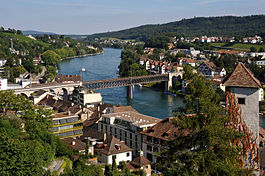Feuerthalen
| Feuerthalen | ||
|---|---|---|
 |
||
|
||
| Coordinates: 47°41′N 8°39′E / 47.683°N 8.650°ECoordinates: 47°41′N 8°39′E / 47.683°N 8.650°E | ||
| Country | Switzerland | |
| Canton | Zurich | |
| District | Andelfingen | |
| Area | ||
| • Total | 2.48 km2 (0.96 sq mi) | |
| Elevation | 400 m (1,300 ft) | |
| Population (Dec 2015) | ||
| • Total | 3,564 | |
| • Density | 1,400/km2 (3,700/sq mi) | |
| Postal code | 8245 | |
| SFOS number | 0027 | |
| Surrounded by | Büsingen am Hochrhein (DE-BW), Flurlingen, Laufen-Uhwiesen, Schlatt (TG), Schaffhausen (SH) | |
| Website |
www SFSO statistics |
|
Feuerthalen is a municipality in the district of Andelfingen in the canton of Zürich in Switzerland. Langwiesen also belongs to the same municipality.
Feuerthalen is first mentioned in 876 as Langewisa. In 1318 it was mentioned as Fuirtal an dem Rine.
Feuerthalen has an area of 2.5 km2 (0.97 sq mi). Of this area, 16.1% is used for agricultural purposes, while 43.8% is forested. Of the rest of the land, 38.6% is settled (buildings or roads) and the remainder (1.6%) is non-productive (rivers, glaciers or mountains).
It is located on the left bank of the Rhine river and provided the bridgehead on that side of the river for the city of Schaffhausen. It includes the village of Langwiesen.
Feuerthalen has a population (as of 31 December 2015) of 3,564. As of 2007[update], 19.4% of the population was made up of foreign nationals. Over the last 10 years the population has grown at a rate of 24%. Most of the population (as of 2000[update]) speaks German (91.2%), with Italian being second most common ( 3.0%) and Albanian being third ( 1.3%).
In the 2007 election the most popular party was the SVP which received 37.4% of the vote. The next three most popular parties were the SPS (20.9%), the CVP (10.7%) and the Green Party (10.4%).
The age distribution of the population (as of 2000[update]) is children and teenagers (0–19 years old) make up 20.9% of the population, while adults (20–64 years old) make up 60.2% and seniors (over 64 years old) make up 19%. About 76.2% of the population (between age 25-64) have completed either non-mandatory upper secondary education or additional higher education (either university or a Fachhochschule).
...
Wikipedia



